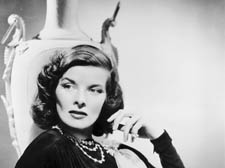
Katharine Hepburn |
The enigma that was Katharine Hepburn
A new biography on Katharine Hepburn uncovers the woman behind the myth, writes William Hall order this book
WE were sitting in the Californian sunshine, Spencer Tracy and I, in orange canvas chairs outside a Bel-Air mansion high above Los Angeles, watching a scene from Guess Who’s Coming to Dinner. On the doorstep Katharine Hepburn and Sidney Poitier were talking animatedly while the cameras rolled.
Tracy, the old lion in the winter of his career and his life, couldn’t take his eyes off her.
“Good girl,” he growled fondly, almost to himself, as director Stanley Kramer called “Cut!” and another scene was safely in the can. He turned to me. “She’s winning this one,” he said.
Tracy was right. Hepburn went on to win the best actress Oscar for her role as the mother of a well-to-do family whose daughter stuns her parents by announcing she is going to marry a black man. In those days, 1967, this was heavy stuff for the cinema, and it brought mixed reviews even as it crossed another milestone in public acceptance.
It all came back to me this week with the publication of Kate, William J Mann’s meticulously detailed biography of the enigma that was Katharine Hepburn. Enigma so often leads to myth, and myth to legend.
He pulls no punches when he charts Hepburn’s relationships with other women, linked with names led by heiress Laura Harding, socialite Hope Williams, and actress Phyllis Wilbourn.
Yet in 1928 she had married wealthy Ludlow Ogden Smith, divorcing him within six years, and was later rumoured to be close to her agent Leland Hayward and with Howard Hughes: Cate Blanchett played her in the film Aviator, remember?
Mann comments: “Sex, whether with men or women, was never an overriding determinant for Hepburn’s significant relationships.” And he reveals how Hepburn mischievously enjoyed giving Hollywood rich fodder for the guessing game.
Close to a quarter of his book has the presence of Spencer Tracy looming large in its pages. The couple made nine films together.
They first set eyes on each other when they were cast together in Woman of the Year in 1942, a comedy directed by George Stevens about a rough-diamond sports columnist who marries an elegant female politician. It resulted in their famous opening exchange in the producer’s office: “You realise I’m as tall as you are.” And his swift response: “Don’t worry. I’ll cut you down to size.” After which they never looked back.
Since 1962 Tracy’s health had been declining rapidly. He had given up alcohol, and in turn Kate gave up acting for five years to care for him. Until 1967, and Guess Who’s Coming to Dinner.
I was there by invitation, and witnessed Hollywood’s best-kept open secret: the pair were in a deep and loving relationship that stretched way beyond the cameras.
One month later Tracy was dead.
He died from a heart attack in his bungalow home. Kate, sleeping in the maid’s room close by, heard a crash and hurried in. She cradled him in her arms, but it was too late. Her beloved Spence was gone. Tracy was 67, she was 60.
Kate would continue for another 34 years until her own death in 2003 at the age of 96. During that time there were more awards and plaudits, but a gap in her life remained that could never be filled.
We all remember Hepburn as tall and formidable, with piercing blue eyes and a voice that was sharp enough to slice open an envelope. Born in 1907 in Hartford, Connecticut, daughter of noted surgeon Dr Thomas Hepburn, she made her mark in college dramatics. She also earned a degree in psychology.
Her mother Katharine was a vocal suffragette, and Hepburn inherited her strong-minded and outspoken character, ruffling feathers in the close-knit Hollywood oligarchy when she made it to tinsel town.
But her consummate talent finally gained her recognition. Her performance in Morning Glory as an ambitious young starlet won her the Academy Award for best actress, and Kate was on her way to her own personal glory.
There would be three more Oscars (Guess who’s Coming to Dinner, The Lion in Winter, On Golden Pond) plus no fewer than eight nominations (Alice Adams, The Philadelphia Story, Woman of the Year, The African Queen, Summertime, The Rainmaker, Suddenly Last Summer and Long Day’s Journey into Night) with an adoring public avidly following her relentless trek to stardom.
What makes Mann’s biography remarkable is the feeling that here we have a terrier who digs deeper than most. Indeed, he recounts how as a cub reporter in Hartford he uncovered the fact that her birth date was two years earlier than she had always professed.
Brave fellow, he sent her a copy of his story – and was amazed to receive a two-word reply: “Good sleuthing.” Proving the lady – enigma, myth or legend – had a sporting streak, and an unexpected sense of humour too.
n Kate by William J Mann, Faber and Faber, £18.99.
n William Hall is a biographer and broadcaster. His most recent books include biographies on Michael Caine, James Dean, Norman Wisdom and Robert Maxwell.
|


